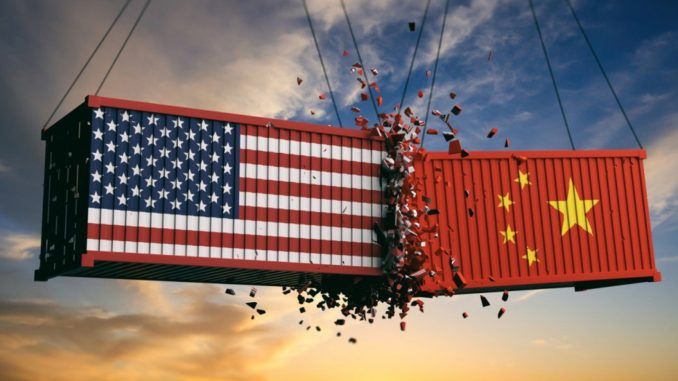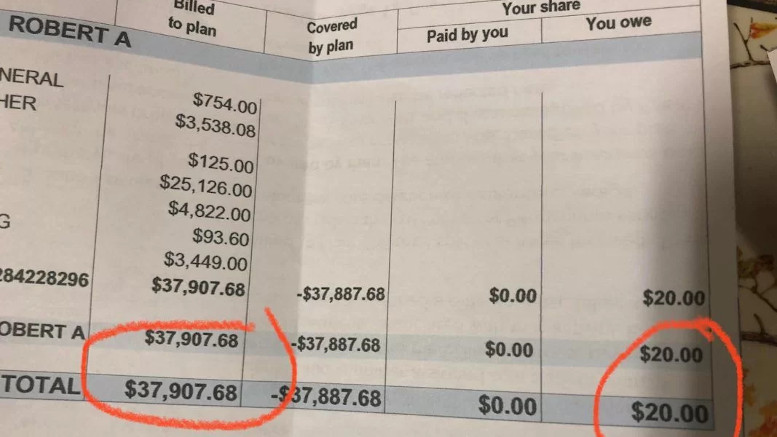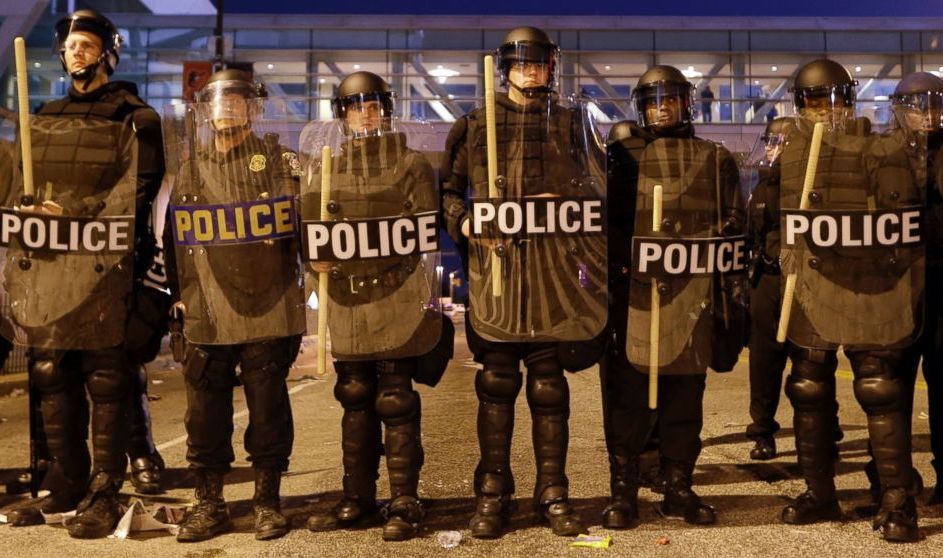Vincent Kolo is a contributor to chinaworker.info.

President Trump’s decision to increase punitive tariffs against China from one minute past midnight on Friday, 10 May, marks a dramatic escalation of the 10-month old trade war between the world’s biggest economies. This follows months of talks and the widespread impression, encouraged by Trump and his officials, that a trade deal was close to hand.
The escalation of the conflict has sent jitters through global financial markets, hitting stocks, currencies and commodity prices. Bloomberg calculated that almost US$1.5 trillion was wiped from global stock indexes in the four trading days following Trump’s “bombshell” tweet the previous Sunday (5 May) threatening higher tariffs. That works out at $13 billion per word!
The US and China are playing “Russian roulette with the world economy” protested the president of the European Union Chamber of Commerce in China. The real losers, rather than the capitalists who are complaining about disruption of supply chains and reduced profits, are workers and consumers in the US, China and worldwide, whose jobs and living standards are at stake. US computer technology giant Oracle recently announced 1,600 job cuts in China, with employees at its Beijing Research and Development Centre staging walkouts and protests on 7 May. Oracle’s boss Larry Ellison, one of the wealthiest men in the world, is a vocal supporter of Trump’s trade war against China.
The US tariffs are raised to 25% from 10%, the level set last September, on US$200 billion worth of Chinese imports. This ranges from consumer goods such as vacuum cleaners and furniture to capital goods and components such as auto parts and building materials. A further US$50 billion of Chinese imports are already covered by a tariff of 25%. Trump has also threatened to up the ante by extending tariffs to the remaining US$325 billion of Chinese imports – taxing everything.
The Chinese regime retaliated last year in tit-for-tat fashion and also vowed this time to take new as yet unspecified countermeasures. The scale and form of these countermeasures will give an indication whether Beijing believes the negotiations that restarted last December have irrevocably collapsed or that Trump’s tariff hike is a negotiating tactic, to “act half crazy”, a possibility raised by billionaire Warren Buffet.
China sells almost four times as much to the US than it buys in return and therefore any tariff war between the two countries is ‘asymmetrical’, increasing the possibility that China could retaliate in other ways – through depreciation of its currency or taking measures against US companies based in China – although at this stage neither of these options is likely.
Threat to world growth
For the strategists of global capitalism this turn of events is alarming as underlined by the comment of the French Finance Minister Bruno Le Maire, “There is no greater threat to world growth”. A full-blown trade war between the two superpowers, a reality if Trump makes good on his threat to slap tariffs on all remaining Chinese goods, could translate into a contraction of global trade by 2% and cause global GDP to slow by 0.8% according to the Guardian.
Even before the latest tariff escalation, the IMF had downgraded its 2019 growth forecasts three times in six months, predicting in April that the global economy will grow 3.3% this year, the weakest rate of growth since 2009.
The US economy could be hit just as hard as China’s by the escalation of the trade war. Many economists predict inflation will ticks upwards as the tariffs feed into higher US consumer prices. One study calculates the cost to the average US household of higher tariffs on Chinese products to be US$767 a year. Faster inflation could put additional pressure on the Federal Reserve to increase interest rates despite Trump’s efforts to get it do just the opposite. The stock market boom since the start of the year is built more than anything else on hopes for a rapid resumption of the Fed’s loose money regime, which has acted like rocket fuel for financial speculation and an ever more parasitical capitalism.
Wide sections of the US ruling class support Trump’s harder line against China, especially while the US economy appears to be strong – an illusion in our opinion – but many also complain that the president’s tariffs are a “blunt instrument” and would prefer a united front approach against China to enlist the support of other Western capitalist governments.
These events underline how unstable and volatile world relations have become as “the world’s most important bilateral relationship”, between the US and China, spirals downwards. Last year marked a major turning point, and the start of a new era of imperialist great power antagonisms often summed up in the concept of a “new cold war”. This shift is not solely or mainly as result of Trump’s political make-up, but flows from the nature of imperialism, which as Leon Trotsky said, “abhors any division of power”. China’s rise, its ability increasingly to compete with American capitalism in key markets, has pushed it into the cross hairs – at least in economic terms – of the US ruling class and state.
Other potentially very big trade disputes loom, over cars for example, with Trump threatening more tariffs against Japanese and European manufacturers. Aircraft and steel are other areas of conflict between the US and the EU. These are precisely the “allies” the US should bloc with to exert pressure on China according to many of Trump’s capitalist critics.
“Two autocratic men”
The sudden possible collapse of the détente process initiated by Trump and Xi last December, which has seen eleven rounds of intensive shuttle diplomacy between Washington and Beijing described incessantly as “productive” and “going very well” not least by the US president himself, points to increasing serious political and economic pressures on both sides of the Pacific. Both the Trump and Xi regimes risk being swept into a political storm if they are perceived to have delivered a weak agreement (Trump) or made too many concessions (Xi).
“Global trade is now hostage to the fragile egos of two autocratic men” commented Jamil Anderlini in the Financial Times. While this is an oversimplification there is undoubtedly some truth here. The price for both leaders is extremely high, possibly even costing them their hold on power, should they sign an unpopular or humiliating accord. Both regimes are partly captives of their own demagogic nationalism encapsulated in the slogans “Make America Great Again” and its Chinese equivalent.
While both Beijing and Washington want to project strength, in reality both fear the effects of this conflict, which have moved beyond the relatively painless phase of the initial few months of tariffs. Trump will face increasing pressure in key farming states, which helped him win the 2016 election, and which are already suffering from China’s retaliatory tariffs on US soybeans. Last year Trump’s government initiated a US$12 billion support fund for farmers, most of which goes to big agribusiness, labelled by some as “socialism for farmers”. As the latest tariffs kicked in, Trump tweeted he would buy US$15billion of US farm products with the proceeds from his tariffs and send it to “poor and starving countries” as humanitarian aid.
U-turns
In our previous analysis on chinaworker.info, while like most commentators we believed a deal was the most likely outcome (and this is still not excluded), we explained that, “Clearly, the two sides are not as close as they want people to think. But they are also under pressure to de-escalate, without losing face. This last point is what’s mainly causing the negotiations to drag out.”
The build up to the May 10 escalation seems to be a u-turn or series of u-turns by the two main protagonists. Trump blames the Chinese side for “reneging” on previous commitments. “They broke the deal,” he told a campaign rally in Florida. The US government’s version has been widely accepted by most media worldwide, but as details of the 150-page draft trade agreement are still secret this is impossible to verify.
While this type of blame game is a familiar practise of diplomacy, and while we are entitled to be sceptical towards any statement from the Trump White House, reports are emerging from China to suggest there has indeed been push back from within the regime, including pressure from nationalist hardliners, against making too many concessions to Trump. This includes the alleged comment of Xi Jinping, “I will be responsible for the consequences”.
“Matters of principle”
Liu He, China’s chief negotiator, threw more light on this in comments made as he was leaving Washington following the abortive and rather perfunctory eleventh round of talks, which lasted just three hours in total, and unsurprisingly failed to prevent Trump’s escalation. While trying to downplay the crisis, saying “small setbacks are inevitable”, Liu denied China had “reneged” on previous areas of agreement. From a transcript of his speech posted on Hong Kong-based website Pheonix Television, Liu identified three key issues over which attempts to reach a deal have faltered.
The first is Beijing’s insistence that all Trump’s tariffs are removed, with the US side pushing for at least some tariffs to remain in force or for a phased removal to insure China’s compliance.
The second relates to China’s procurement of US goods – major purchases of agricultural and other goods – which were already put on the table when Xi and Trump met in December on the sidelines of the G20 summit in Buenos Aires. According to Liu the two sides now have different views on what was actually agreed, with the US evidently demanding a cash sum the Chinese side are not prepared to meet.
The third issue concerns the Trump team’s insistence that China’s government commits to incorporate key aspects of the agreement into Chinese law to address US complaints over theft of intellectual property and trade secrets, forced technology transfers, competition policy and subsidies to state companies, US access to the China’s financial sector, and currency “manipulation”.
The clear connotation of such an accord would be to cast China and Xi’s regime in a submissive role, echoing the ‘unequal treaties’ forced upon China by imperialism in the past. It is unsurprising therefore that Liu stated these were “matters of principle” over which the Chinese side was not prepared to compromise. However, US objections in respect to technology and intellectual property have also become “matters of principle” – these are essential parts of Trump’s program and a big part of the reason he gets the support of US capitalists in this conflict.
The ghost of Yuan Shikei
The Chinese regime has been prepared to make concessions in order to reach a deal with Trump’s government, while also understanding this won’t fundamentally shift the trajectory of US-China relations, which is towards sharper great power rivalry. The Chinese regime’s strategy is to achieve a de-escalation of the trade war, to buy time in which to continue its modernisation of industry and build a stronger technological base, cognisant that the country’s social and economic problems are piling up. But as we explained Beijing’s willingness to making concessions has limits:
“But Xi’s regime won’t sacrifice ‘core areas’ which are anything vital to its state capitalist economic model such as state subsidies, protection of key state monopolies and creation of ‘national champions’.” [Can the US and China end their trade war? chinaworker.info 14 April 2019]
The Chinese regime – a dictatorship which combines state-directed capitalist economic development with unprecedented levels of repression and political control – lives in fear of massive social unrest which could endanger its survival. There are multiple challenges in the form of an increasingly sluggish economy, a simmering debt crisis and widening inequality, all of which could be further compounded by the trade offensive of Trump and US imperialism. The regime’s and especially Xi’s aura of invincibility, as an all-powerful ruler at the head of the most expensive police state in history, are necessary ingredients to its rule. This explains Xi’s refusal, even at the cost of possible serious escalation, to compromise on what his mouthpiece Liu He called “matters of principle”.
With good reason, Xi fears he could be attacked as a “weak” ruler by factional enemies within the CCP (so-called Communist Party), which could also become a lightning rod for mass discontent. The 100th anniversary of the May Fourth Movement, which coincided with the latest tariff standoff, provides many lessons for China’s rulers and the masses.
Xi was widely compared last year, when he abolished presidential term limits enabling him to rule indefinitely, to the power-crazed but brief president Yuan Shikei. Yuan proclaimed himself emperor in 1915, but is also remembered as a weak ruler who caved into demands from Japanese imperialism. This was an important part of the background to the May Fourth mass protests in 1919, which marked the start of a decade of revolutionary upheavals. “Xi is very concerned about his authority, as he doesn’t want to be seen like Yuan Shikai,” noted Wu Qiang, a former politics lecturer at Tsinghua University.
Media censorship
The Xi regime’s sensitivity to criticism is illustrated by new tough media censorship to block most reports about the trade war. “We have received instructions that we can only publish comments made by the spokesmen of the commerce and foreign ministries,” the news editor of a major Chinese media outlet told Hong Kong’s South China Morning Post on condition of anonymity.
Xi is therefore forced to tread a very fine line. He does not want to completely abandon the possibility of a trade accord with US imperialism. Hence the restraint shown so far which includes muzzling the Chinese media’s natural predisposition towards strident nationalism and anti-Westernism. This explains why Liu He went to Washington on a thankless mission (although significantly this time stripped of the title “special emissary of president Xi Jinping”), which represented a departure from Beijing’s previous position that it would not negotiate under threat.
Will there be a deal?
A window was left open by the Trump administration with its announcement that the increased tariffs would not apply to goods that left Chinese ports before the May 10 deadline. Those ships already at sea will not face the new tariffs, allowing a further month for a deal to be concluded between the two sides. Liu told the press that new talks would be held, next time in Beijing, but this has been contradicted by some Trump officials. Chinese regime strategists are now comparing the situation to the Korean War (1950-53) in which for two years China, under Mao Zedong, waged war against the US while negotiating at the same time.
Meanwhile Trump has signalled a further escalation with the announcement by Robert Lighthizer, his top trade negotiator, that the government was formally initiating the process to extend tariffs to the remaining US$325 billion of Chinese imports. These tariffs could be introduced in one month, Lighthizer said, although Larry Kudlow who heads Trump’s National Economic Council, said a timeline of “two to three months” is more realistic.
These contending pressures have injected enormous uncertainty into the situation, in which a complete breakdown of the fragile détente process (i.e. all-out trade war) is one possibility, as is a largely cosmetic trade agreement, but also a prolonged stalemate in which talks continue, punctuated by new threats and crises.
The confusion is compounded by Trump’s habit of sending out sharply contradictory signals, Jekyll-and-Hyde-style, suggesting wildly different outcomes. Trump spoke of a “beautiful letter” he received from Xi Jinping, but within hours accused the Chinese regime of stalling in the hope they’ll “get lucky” with a Democratic victory in next year’s presidential elections (Beijing is in fact fully aware that a Democratic White House could stand for an even tougher anti-China line).
This uncertainty was summed up by UBS financial strategist Chris Krueger, “To paraphrase Lenin: there are decades where nothing happens and there are weeks when decades happen… and then there is a single week in the Trump Presidency. What a time to be alive.”
This is not a reassuring scenario even for US capitalism. “We are concerned that this gets worse and instead of a tariff regime that lasts for a few months, we see a tariff regime that lasts for years,” a spokesman for the US National Retail Federation told the Financial Times.
The bigger picture, where US-China relations have shifted onto a completely different and fundamentally antagonistic trajectory is largely unchanged, although a complete breakdown in the trade talks can inflame other areas of contention.
Even with a trade deal, there is a concerted pushback by the US against Chinese tech companies, most notably Huawei, and against China’s Belt-and-Road Initiative – Xi’s grand infrastructure strategy to construct a 70-nation China-centric economic sphere as a counterweight to US economic and financial dominance. Just the day before Trump’s tariff escalation, China Mobile, the world’s biggest telecom company, was banned from operating in the US market as a “threat to national security”.
US-China rivalry is also intensifying over maritime disputes in the Western Pacific and South China Sea, over Taiwan, which could become a major flashpoint in future, and even in Africa and Latin America where the interests of the two superpowers are increasingly at odds.
Today’s political and diplomatic uncertainty, not to say chaos, with global trading rules and capitalist international institutions such as the IMF and WTO weakened and increasingly sidelined, is indicative of a global system in decay. Capitalist nationalism, of which both Trump and Xi are exponents in different forms, is no more of a solution than the globalised neo-liberal order favoured by the main wing of the capitalist class internationally for more than three decades. Likewise, both US-style “free market” capitalism and China’s authoritarian capitalism represent two variants of a redundant economic system. The working class is the only force, drawing behind it all the oppressed, which can put an end to this chaotic state of affairs, by fighting for international socialism and democratic planning.



